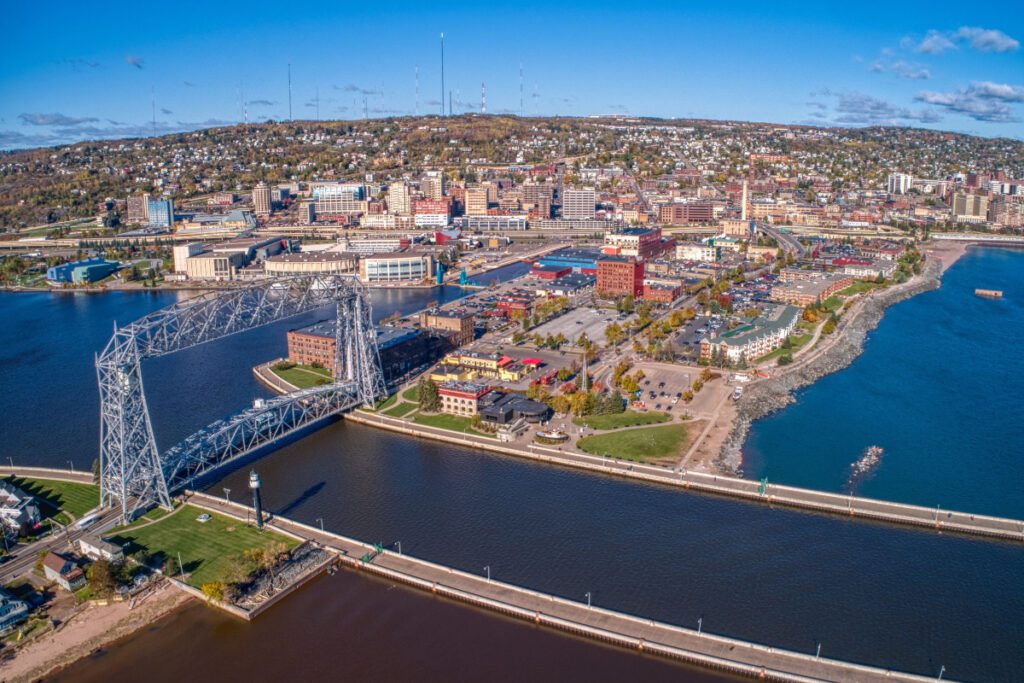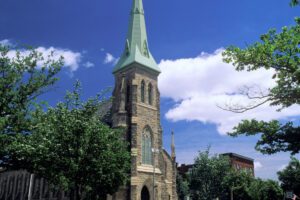You want to become a homeowner but aren’t sure how you’re going to save up for your down payment. Typically, you’re going to need at least 3% to 5% for a down payment for a conventional mortgage, or 20% on a loan that doesn’t require private mortgage insurance.
Fortunately, there are a number of methods you can use to stash away money for your future home. Here are some of the best ways to save for a house and get one step closer to your dream.
1. Creating a Budget
Living on a budget may not be easy, but in the long run it can help you save money to put toward a home purchase. Creating a budget to track where your money is going is a good first step in a house savings plan.
Some effective ways to do this are recording expenses in a spreadsheet or using a budgeting app to determine your spending practices and identify where changes can be made to meet your savings goal.
💡 Quick Tip: Want to save more, spend smarter? Let your bank manage the basics. It’s surprisingly easy, and secure, when you open an online bank account.
2. Using Cash Envelopes
The theory behind this method is that it may be harder to part with cash than it is to swipe a debit or credit card. The cash envelope budgeting method involves distributing cash each month (or pay period) into envelopes based on categories you establish. When you’re out of cash for each category, you stop spending.
3. Deleting Your Stored Cards
Do you store your payment information on Amazon or other e-commerce stores? If so, it’s time to consider deleting them from each store or from your browser settings. If you have to manually input your card each time you want to make a purchase, you may just stop spending so much money online.
4. Downsizing Your Life
Another one of the tips for saving for a house involves downsizing your life. This could mean moving to a smaller rental or to a more affordable area of town. Just keep in mind that there is always a flip side to downsizing. For instance, your smaller apartment may not include parking, so you might be taking on an expense you didn’t have before. Moving to a different part of town might mean spending more on transportation costs getting to work each day. It’s a good idea to weigh the pros and cons before making any big decisions.
5. Setting Up Automatic Transfers
Reaching your savings goals might happen faster by setting up automatic transfers from checking account to savings account each time you’re paid. If your paycheck is direct-deposited, you may also be able to split the deposit into more than one account, on a percentage or dollar-amount basis.
6. Postponing Vacation
This method can reap plenty of savings if your usual vacation is a costly one. Instead of taking a big trip, a staycation may be entertaining and less expensive. Check out your local newspaper’s website to find free activities and events in your area. Art museums sometimes offer free admission days, and area nature trails are generally free and can be a good way to have fun and get exercise in one fell swoop. Now is the time to be creative since you’re working on your house savings plan.
7. Tackling Your Debt
If you get 4.50% APY in your high-yield savings account, but you carry a credit card balance with an interest rate of 23.99%, it may make more sense to put your money towards your debt right now rather than savings.
8. Eating at Home
Dining out is expensive. The average American household spends more than $3,000 per year on eating out. By skipping the takeout and restaurants and cooking your meals at home, you can add that money to your house savings plan.
9. Making Your Own Coffee
It’s a cliche, but it’s true: If you skip the lattes, you could boost your savings. The average American spends $92 per month on coffee, which adds up to about $1,100 per year. Purchasing a coffee maker and brewing your own cup of joe as opposed to hitting up a coffee shop every day will likely improve your home savings plan.
10. Using Coupons at the Grocery Store
Looking for coupons for items you normally buy anyway can trim your grocery bill. Coupons can be found on coupon websites and on brands’ websites.
Recommended: Tips for Grocery Shopping on a Budget
11. Buying Things on Sale
Just because you want something doesn’t mean you need to have it right away. Waiting to buy things when they go on sale is another one of the best tips for saving for a house. Along with looking at stores’ advertised sales, you could always create a Google alert to find out when things go on sale by typing in your favorite stores’ names + sales on Google Alerts.
💡 Quick Tip: If you’re saving for a short-term goal — whether it’s a vacation, a wedding, or the down payment on a house — consider opening a high-yield savings account. The higher APY that you’ll earn will help your money grow faster, but the funds stay liquid, so they are easy to access when you reach your goal.
12. Using Promo Codes
Promo codes are like coupons for online purchases. Browser extensions that search the web for deals can bring those promo codes to you and save you precious search time and effort.
13. Cutting Out Cable
Cable television can be a major monthly expense for some households, sometimes hundreds of dollars every month. One of the best ways to save is to cut the cord, switch to streaming services, and potentially pay much less per month on your favorite entertainment by saving on streaming services.
14. Canceling Your Subscriptions
You may be spending money on monthly subscriptions without realizing how much. Canceling subscriptions to things like lifestyle boxes you aren’t using anymore or magazines you don’t read can add up to significant savings.
15. Making the Most of the Library
The local library is a fantastic resource. You can borrow books, magazines, and movies instead of buying them, and some libraries even offer access to free audiobooks. Libraries are funded by taxes, so you’re probably already contributing to this resource—there’s little reason to pay twice for items it provides as a public service.
16. Canceling Your Gym Membership
Gym memberships can be pricey, but exercise is not. Using free, online workout videos and things in your home as exercise equipment (e.g., stepping on your stairs, doing wall or table pushups, or using a chair for barre exercises), or walking around your neighborhood can save money over a gym membership.
17. Shopping Around for Insurance
You may be overpaying for insurance. Comparing rates and getting different quotes for your car, renter’s, pet, health, and other types of insurance can ensure you’re getting the best deal possible.
18. Steering Clear of Checking Account Fees
Is your bank charging you a monthly maintenance fee just to keep your account open? If so, it might be worth looking into switching banks or asking your bank how you can avoid these fees. For example, if you have a direct deposit into the account or maintain a minimum daily account balance, you may be eligible for a fee-free account.
19. Selling Your Stuff
Do you have things you never use anymore? Could they fetch some cash? Holding a garage sale or selling your stuff online might net a few dollars to add to your house savings plan. You’ll probably want to buy new things for your new home anyway, and selling your old things will allow you to save up.
20. Asking Your Boss for a Raise
During your annual performance review, consider asking for a raise, highlighting your accomplishments and why you deserve more money. Be specific about improvements you’ve made to the company by backing up your accomplishments with data.
21. Switching to a Better Job
If you aren’t making enough money in your current position, then consider switching to a higher-paying job. It’s a good idea to keep your current job until you find a new one, though.
22. Taking on a Side Hustle
If you have the time and energy, earning extra money on nights and weekends with a side hustle might be an option. For instance, you could start a dropshipping business, take up freelancing, or do affiliate marketing.
23. Signing Up for a Travel Rewards Credit Card
If you need to travel or you are still planning a vacation, using a travel rewards credit card may be a good idea. These cards offer certain rewards for different categories such as travel, gas, and dining out, and allow you to put your rewards towards flights, hotels, rental cars, and more. Plus, many of them offer other ways to save, such as providing you with rental car and baggage delay insurance or no foreign transaction fees.
Recommended: Credit Card Rewards 101: Getting the Most Out of Your Credit Card
24. Getting a Cash Back Credit Card
With a cash-back credit card, you can earn cash rewards every time you spend. Putting that cash back toward a statement credit or bank transfer will help accelerate your savings.
25. Renting Your Spare Room
If you have an extra room in your apartment that you aren’t using, you could get a roommate or list it on a rental site to reduce your overall living expenses. Just make sure that you get permission from your landlord before inviting anyone else to move in.
26. Renting Out Your Storage Space
Another one of the best ways to save for a house is to rent out your unused storage space on a peer-to-peer site. You could generate income without having to do much work at all, and you won’t have to live with someone else—just their stuff.
27. Making Your House Savings Plan Known
Your Aunt Mildred may always get you boxes of chocolates for your birthday, and your dad might give you gift cards for Amazon. But letting your family and friends know you’re trying to save for a home might plant the seed for them to give you cash instead. If you’re getting married, this is a time to tell people about your plans so that instead of registry gifts, they might give you cash for your future home.
28. Opening a High-Yield Savings Account
Putting your money into a regular savings account may not result in much of a return. However, putting money in a high yield savings account may net more interest and get you closer to reaching your savings goals. A high-yield savings account typically offers 20 to 25 times the national average of a typical savings account.
29. Hiring an Accountant at Tax Time
If you’ve been doing your taxes on your own every year, you may have missed potential tax savings you might be eligible for. A tax professional may be able to maximize your savings, possibly resulting in a larger refund, or minimize taxes you owe.
30. Saving Your Tax Refund
If you get a tax refund, consider saving it instead of spending it. The money can be a nice addition to your down payment, possibly even earning interest in high-yield savings account until you need it.
31. Changing Your Tax Withholding
Among the best ways to save for a house is by keeping more money from your paycheck. If your withholding is too high, the IRS is essentially holding your money for you all year round. Instead of getting a large tax refund, keeping your money now and investing it in an interest-bearing account will help you save up for your home.
The Takeaway
Saving for a house takes some time and effort, but there are many different ways to do it. For instance, by eating out less, you could potentially save thousands of dollars a year. Launching a side hustle could increase your income. And opening a high-yield savings account, which typically offers considerably higher interest rates than a traditional savings account, could also help your money grow — and help you achieve your dream of home ownership.
Interested in opening an online bank account? When you sign up for a SoFi Checking and Savings account with direct deposit, you’ll get a competitive annual percentage yield (APY), pay zero account fees, and enjoy an array of rewards, such as access to the Allpoint Network of 55,000+ fee-free ATMs globally. Qualifying accounts can even access their paycheck up to two days early.
Better banking is here with up to 4.50% APY on SoFi Checking and Savings.
Photo credit: iStock/Talaj
Third-Party Brand Mentions: No brands, products, or companies mentioned are affiliated with SoFi, nor do they endorse or sponsor this article. Third-party trademarks referenced herein are property of their respective owners.
Financial Tips & Strategies: The tips provided on this website are of a general nature and do not take into account your specific objectives, financial situation, and needs. You should always consider their appropriateness given your own circumstances.
SoFi® Checking and Savings is offered through SoFi Bank, N.A. ©2023 SoFi Bank, N.A. All rights reserved. Member FDIC. Equal Housing Lender.
The SoFi Bank Debit Mastercard® is issued by SoFi Bank, N.A., pursuant to license by Mastercard International Incorporated and can be used everywhere Mastercard is accepted. Mastercard is a registered trademark, and the circles design is a trademark of Mastercard International Incorporated.
4.50% APY
SoFi members with direct deposit activity can earn 4.50% annual percentage yield (APY) on savings balances (including Vaults) and 0.50% APY on checking balances. Direct Deposit means a deposit to an account holder’s SoFi Checking or Savings account, including payroll, pension, or government payments (e.g., Social Security), made by the account holder’s employer, payroll or benefits provider or government agency (“Direct Deposit”) via the Automated Clearing House (“ACH”) Network during a 30-day Evaluation Period (as defined below). Deposits that are not from an employer or government agency, including but not limited to check deposits, peer-to-peer transfers (e.g., transfers from PayPal, Venmo, etc.), merchant transactions (e.g., transactions from PayPal, Stripe, Square, etc.), and bank ACH funds transfers and wire transfers from external accounts, do not constitute Direct Deposit activity. There is no minimum Direct Deposit amount required to qualify for the stated interest rate.
SoFi members with Qualifying Deposits can earn 4.50% APY on savings balances (including Vaults) and 0.50% APY on checking balances. Qualifying Deposits means one or more deposits that, in the aggregate, are equal to or greater than $5,000 to an account holder’s SoFi Checking and Savings account (“Qualifying Deposits”) during a 30-day Evaluation Period (as defined below). Qualifying Deposits only include those deposits from the following eligible sources: (i) ACH transfers, (ii) inbound wire transfers, (iii) peer-to-peer transfers (i.e., external transfers from PayPal, Venmo, etc. and internal peer-to-peer transfers from a SoFi account belonging to another account holder), (iv) check deposits, (v) instant funding to your SoFi Bank Debit Card, (vi) push payments to your SoFi Bank Debit Card, and (vii) cash deposits. Qualifying Deposits do not include: (i) transfers between an account holder’s Checking account, Savings account, and/or Vaults; (ii) interest payments; (iii) bonuses issued by SoFi Bank or its affiliates; or (iv) credits, reversals, and refunds from SoFi Bank, N.A. (“SoFi Bank”) or from a merchant.
SoFi Bank shall, in its sole discretion, assess each account holder’s Direct Deposit activity and Qualifying Deposits throughout each 30-Day Evaluation Period to determine the applicability of rates and may request additional documentation for verification of eligibility. The 30-Day Evaluation Period refers to the “Start Date” and “End Date” set forth on the APY Details page of your account, which comprises a period of 30 calendar days (the “30-Day Evaluation Period”). You can access the APY Details page at any time by logging into your SoFi account on the SoFi mobile app or SoFi website and selecting either (i) Banking > Savings > Current APY or (ii) Banking > Checking > Current APY. Upon receiving a Direct Deposit or $5,000 in Qualifying Deposits to your account, you will begin earning 4.50% APY on savings balances (including Vaults) and 0.50% on checking balances on or before the following calendar day. You will continue to earn these APYs for (i) the remainder of the current 30-Day Evaluation Period and through the end of the subsequent 30-Day Evaluation Period and (ii) any following 30-day Evaluation Periods during which SoFi Bank determines you to have Direct Deposit activity or $5,000 in Qualifying Deposits without interruption.
SoFi Bank reserves the right to grant a grace period to account holders following a change in Direct Deposit activity or Qualifying Deposits activity before adjusting rates. If SoFi Bank grants you a grace period, the dates for such grace period will be reflected on the APY Details page of your account. If SoFi Bank determines that you did not have Direct Deposit activity or $5,000 in Qualifying Deposits during the current 30-day Evaluation Period and, if applicable, the grace period, then you will begin earning the rates earned by account holders without either Direct Deposit or Qualifying Deposits until you have Direct Deposit activity or $5,000 in Qualifying Deposits in a subsequent 30-Day Evaluation Period. For the avoidance of doubt, an account holder with both Direct Deposit activity and Qualifying Deposits will earn the rates earned by account holders with Direct Deposit.
Members without either Direct Deposit activity or Qualifying Deposits, as determined by SoFi Bank, during a 30-Day Evaluation Period and, if applicable, the grace period, will earn 1.20% APY on savings balances (including Vaults) and 0.50% APY on checking balances.
Interest rates are variable and subject to change at any time. These rates are current as of 8/9/2023. There is no minimum balance requirement. Additional information can be found at http://www.sofi.com/legal/banking-rate-sheet..
SOBK0923005
Source: sofi.com



